Reflecting on Twenty Years of the NRSD Program
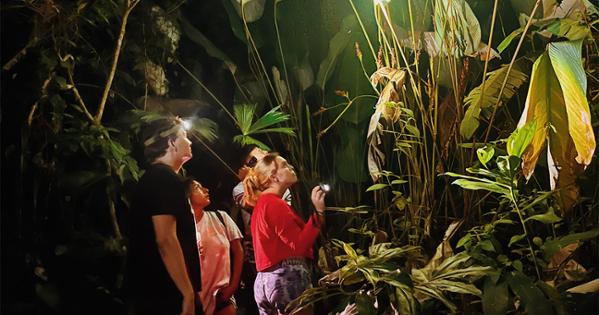
Twenty years ago, the modern environmental movement, marked by the celebration of the first Earth Day in 1970, was approaching middle age. An influential essay by two leaders in the field titled “The Death of Environmentalism” had sparked an internal conflict among the so-called “green groups.” The phrase “global warming” was the norm, and programs examining how people might successfully adapt—and even thrive—in a changing climate were few and far between. The ideas bolstering sustainable development, especially that which might occur in the Global South and for the benefit of those who stood most directly in the path of harm from climate change, were nascent and not mainstream.
Into this challenging landscape, SIS and a new partner, the University for Peace (UPeace) in Costa Rica, embarked upon the creation of an innovative graduate program that would attempt to fill gaps many didn’t know existed. And happily, this year SIS is marking the 20th anniversary of the Natural Resources and Sustainable Development (NRSD) master’s program at SIS. NRSD is a truly unique program that offers students a combination of classroom expertise and unparalleled field experience at two campuses. Students in the NRSD program spend one year in Washington, DC, and one year at UPeace in Costa Rica learning from experts in the classrooms and gaining on-the-ground experience from local communities in the field.
To celebrate this milestone and to learn more about the program from its inception to now, we caught up with some of NRSD’s founders, faculty, and alumni.
Turning an idea into a reality
In 2000, then-SIS dean Louis Goodman was approached by a renowned environmentalist and the founder of Earth Day, Maurice Strong, to assist in reconstituting the University for Peace in Costa Rica. UPeace is the only UN-mandated higher education institution, and Strong was tasked by UN leadership with modernizing the university. Strong drew inspiration for the future of UPeace from the way that SIS was structured and its encouraging growth. With Strong leading the business and organizational development of the school, Goodman focused on building a new degree program and hiring a new faculty.
“I used the master’s program structure of SIS as the basis, and while I was there, I saw that the best faculty were environmentalists,” explained Goodman.
Through this process of reconstituting UPeace, Goodman realized that the faculty and location in Costa Rica offered unique opportunities for students interested in international development. At the same time, SIS was just beginning its own Global Environmental Policy (GEP) program, and Goodman had the idea of combining the policy expertise of SIS with the location and environmental focus of UPeace. Thanks to the established relationship between Goodman and UPeace, the NRSD program was born, and its first cohort graduated with dual degrees from both SIS and UPeace in 2004.
“We found that this combination would allow students to spend time in Washington getting exposed to policy, and then spend time in Costa Rica getting exposed to the environment in an unusual place. The rest is history,” said Goodman.
A strategic partnership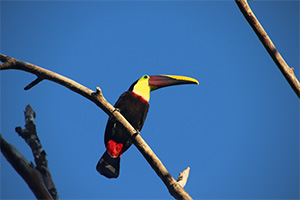
UPeace offers students a multitude of opportunities for learning inside and outside the classroom. The dual nature of the program allows NRSD students to explore issues and topics in multiple settings and contexts.
“Students come from the US to Costa Rica and can see how these topics play out on the ground in both sites,” said Olivia Sylvester, head of the UPeace Environment and Development Department. “It gets to the heart of natural resource management and shows that it’s about politics, scale, and international relationships.”
Costa Rica is a particularly advantageous location for a program like NRSD, because it is one of the most environmentally friendly nations. Costa Rica has a history of focusing efforts on environmental preservation and enacting pro-environmental policies. Beyond its policies, Costa Rica boasts one of the most diverse landscapes in the world. From rainforests to beaches, students experience the wide variety of ecosystems that Costa Rica has to offer.
“Costa Rica has not just great ecological diversity but also great national diversity, and it exposes our students to people from all around the world in a wonderful location,” said Goodman.
As the program continued to grow and develop, it attracted students in a steady stream. Between the allure of a year in Costa Rica, the opportunity for unique internships and travel, and the promise of two degrees in one, many students looking for an adventure with a purpose found the NRSD program to be a perfect fit.
Adam Norikane, SIS/MA ’07, recalls how he found the NRSD program at a unique time in his life: “I was in the Peace Corps in Senegal when I saw an ad for SIS and the NRSD program in a magazine, and I remember circling that ad in my grass roof hut and saying, ‘I want to go to this school, and I want to do that program.’ Fast forward three or four years, and I returned from the Peace Corps, decided to go back to graduate school, and applied to the program.”
Learning in the classroom and the field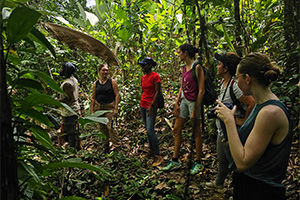
Students in the NRSD program split their time between the two campuses, spending their first and fourth semesters in Washington and their second and third semesters in Costa Rica. This schedule allows students to maximize their time outside of the US, with many students taking the summer to complete international internships before returning to UPeace. Students take classes in global environmental policy, economics, agriculture, and political ecology. NRSD students also take intensive Spanish language courses to prepare them for living and learning abroad.
In Costa Rica, NRSD students split time between the classroom and field experience, as courses are offered on a three-week intensive schedule, which allows time for extended field trips. While out in the field, students meet with local residents, observe agricultural methods, and experience firsthand the sustainability and conservation initiatives taking place in the country.
“Those moments when we are out in the field experiencing real-world things and talking to real people really help to bond the group, which is a big pro of this program for me,” said UPeace professor Jan Breitling.
One current NRSD student, Amanda Clark, SIS/MA ’25, spent this past semester in Costa Rica learning from Costa Ricans, traveling to new places, and soaking up all of the cultural experiences the program has to offer.
“We’re learning from the people who are doing the work that we’re interested in and getting to learn about how the ecosystem landscape and the community landscape play and work together,” said Clark.
Back on campus at SIS, NRSD students wrap up their final semester by engaging in seminars on a wide range of topics. SIS professor Scott Freeman teaches seminars for the program, including one on Costa Rican pineapple production and its effects. By combining policy knowledge with field experience, students can develop a well-rounded understanding of the complex dynamics that many issues relating to natural resources and sustainable development have.
“You could read about all of these issues, but getting to speak with people, interview them, and understand their lives is what is distinct about this program,” said Freeman.
Preparing students for the future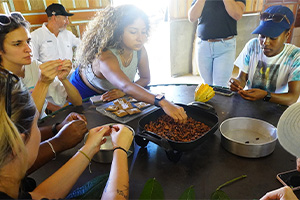
SIS professor Judith Shapiro is the director of the NRSD program and has seen each cohort through to graduation since the very beginning. Thanks to the nature of the dual degree program, students are prepared to enter the workforce with international experience, policy knowledge, and cultural and language skills acquired during their time in the program. Graduates of the NRSD program have gone on to work in various industries and careers, but no matter where they end up, Shapiro and the connections made through the NRSD program are there to support the alumni.
“We have a really extensive alumni network and group, and we have a yearly conference for them to come back and share what they’ve been working on,” said Shapiro.
Alumni of the NRSD program have gone on to work in both the public and private sectors, including major environmental agencies and conservation groups. The top employers of NRSD graduates include the US Agency for International Development (USAID), the UN World Food Programme, the US Forest Service, and the US Environmental Protection Agency (EPA).
Isabella Genta, SIS/MA ’20, is putting her NRSD experience to daily use in her role as an Environment and Natural Resources Officer for USAID’s South America regional mission. Genta is currently based in Peru, but her work covers all countries in the Amazon Basin. In her role, she focuses on programs relating to commodity-driven deforestation, low-carbon agriculture, and engagement with the private sector. When asked how the NRSD program helped prepare her for her career path ahead, Genta said, “There could not be a more direct parallel between the things I learned in the program and what I’m doing now... I know how to go into the field and interact with communities, as well as knowing when to raise questions in order for the organization to continue to improve.”
For NRSD alumnus Moses Jackson, SIS/MA ’14, his experience in the program prepared him well for his current position leading the Global Climate Change Unit of the US Forest Service Office of International Programs. The office is the international development branch of the Forest Service and combines scientific expertise within the Forest Service to support international partners and their natural resource management, climate change mitigation, and adaptation.
“The NRSD program helped me understand the trade-offs involved in working for a government agency... I learned how best to leverage your role to make a real impact and to utilize the government funds to do the good work you want to do,” said Jackson.
The future of NRSD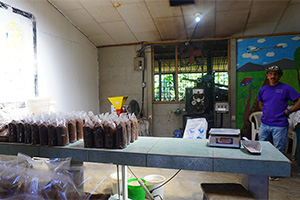
Building on the legacy of the first two decades of the program, more and more students will get to experience the unique duality of this program and will be ready to enter the workforce, whether it’s in sustainable development, conservation, or environmental policy, with a well-rounded education and an unmatched experience.
“When the program started, it was just an idea, and today, 20 years later, there is a much more substantial faculty, alumni base, and interest, all of which will continue to grow this program,” said Goodman.
And, as the NRSD program marks its 20th year, Shapiro looks forward to welcoming future generations of students: “Being with this program for so long means that I am able to meet with an admitted student and tell them, ‘you are going to have an amazing time’ with confidence because I’ve seen the students who go through this program. These students have a sense of adventure.”